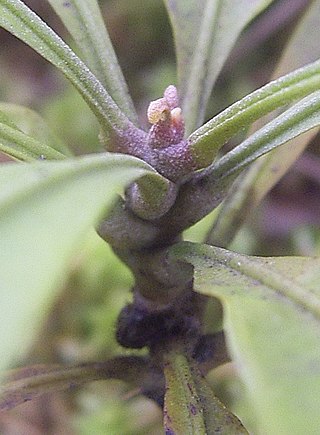Related Research Articles

The Cucurbitales are an order of flowering plants, included in the rosid group of dicotyledons. This order mostly belongs to tropical areas, with limited presence in subtropical and temperate regions. The order includes shrubs and trees, together with many herbs and climbers. One major characteristic of the Cucurbitales is the presence of unisexual flowers, mostly pentacyclic, with thick pointed petals. The pollination is usually performed by insects, but wind pollination is also present.

The Malpighiales comprise one of the largest orders of flowering plants, containing about 36 families and more than 16,000 species, about 7.8% of the eudicots. The order is very diverse, containing plants as different as the willow, violet, poinsettia, manchineel, rafflesia and coca plant, and are hard to recognize except with molecular phylogenetic evidence. It is not part of any of the classification systems based only on plant morphology. Molecular clock calculations estimate the origin of stem group Malpighiales at around 100 million years ago (Mya) and the origin of crown group Malpighiales at about 90 Mya.

The Saxifragales (saxifrages) are an order of flowering plants (Angiosperms). They are an extremely diverse group of plants which include trees, shrubs, perennial herbs, succulent and aquatic plants. The degree of diversity in terms of vegetative and floral features makes it difficult to define common features that unify the order.
Theales is a botanical name at the rank of order. Early classifications such as that of Dahlgren placed the Theales in the superorder Theiflorae. The name was used by the Cronquist system for an order placed in subclass Dilleniidae, in the 1981 version of the system the circumscription was:

Ranunculales is an order of flowering plants. Of necessity it contains the family Ranunculaceae, the buttercup family, because the name of the order is based on the name of a genus in that family. Ranunculales belongs to a paraphyletic group known as the basal eudicots. It is the most basal clade in this group; in other words, it is sister to the remaining eudicots. Widely known members include poppies, barberries, hellebores, and buttercups.

Austrobaileyales is an order of flowering plants consisting of about 100 species of woody plants growing as trees, shrubs and lianas. The best-known species is Illicium verum, commonly known as star anise. The order belongs to the group of basal angiosperms, the ANA grade, which diverged earlier from the remaining flowering plants. Austrobaileyales is sister to all remaining extant angiosperms outside the ANA grade.

The Celastrales are an order of flowering plants found throughout the tropics and subtropics, with only a few species extending far into the temperate regions. The 1200 to 1350 species are in about 100 genera. All but seven of these genera are in the large family Celastraceae. Until recently, the composition of the order and its division into families varied greatly from one author to another.

Violaceae is a family of flowering plants established in 1802, consisting of about 1000 species in about 25 genera. It takes its name from the genus Viola, the violets and pansies.

Violales is a botanical name of an order of flowering plants and takes its name from the included family Violaceae; it was proposed by Lindley (1853). The name has been used in several systems, although some systems used the name Parietales for similar groupings. In the 1981 version of the influential Cronquist system, order Violales was placed in subclass Dilleniidae with a circumscription consisting of the families listed below. Some classifications such as that of Dahlgren placed the Violales in the superorder Violiflorae.

The Bixaceae are a family of dicotyledonous plants commonly called the achiote family. Under the Cronquist system, the family was traditionally placed in the order Violales. However, newer arrangements move it, with some other families previously in the Violales, into the Malvales.

The Passifloraceae are a family of flowering plants, containing about 750 species classified in around 27 genera.

Ochnaceae is a family of flowering plants in the order Malpighiales. In the APG III system of classification of flowering plants, Ochnaceae is defined broadly, to include about 550 species, and encompasses what some taxonomists have treated as the separate families Medusagynaceae and Quiinaceae. In a phylogenetic study that was published in 2014, Ochnaceae was recognized in the broad sense, but two works published after APG III have accepted the small families Medusagynaceae and Quiinaceae. These have not been accepted by APG IV (2016).

The eudicots, Eudicotidae, or eudicotyledons are a clade of flowering plants mainly characterized by having two seed leaves upon germination. The term derives from Dicotyledons.

Chrysobalanaceae is a family of flowering plants, consisting of trees and shrubs in 27 genera and about 700 species of pantropical distribution with a centre of diversity in the Amazon. Some of the species contain silica in their bodies for rigidity and so the mesophyll often has sclerenchymatous idioblasts. The widespread species Chrysobalanus icaco produces a plum-like fruit and the plant is commonly known as the coco plum.

The Rafflesiaceae are a family of rare parasitic plants comprising 36 species in 3 genera found in the tropical forests of east and southeast Asia, including Rafflesia arnoldii, which has the largest flowers of all plants. The plants are endoparasites of vines in the genus Tetrastigma (Vitaceae) and lack stems, leaves, roots, and any photosynthetic tissue. They rely entirely on their host plants for both water and nutrients, and only then emerge as flowers from the roots or lower stems of the host plants.

The Dioncophyllaceae are a family of flowering plants consisting of three species of lianas native to the rainforests of western Africa.

Aphloia is a genus of flowering plants that contains a single species, Aphloia theiformis, the sole species of the monogeneric family Aphloiaceae. It is a species of evergreen shrubs or small trees occurring in East Africa, Madagascar, the Mascarene Islands and the Seychelles.

Huaceae is a family of plant in the rosids group, which has been classed in the orders Malpighiales, Malvales, and Violales or in its own order Huales. The APG II system placed it in the clade eurosids I, whereas the APG III system of 2009 and APG IV (2016) place it within the Oxalidales. The family is endemic to central Africa. It contains four species in the following two genera:

Peraceae Klotzsch is a family of flowering plants in the eudicot order Malpighiales. The family was segregated from the Euphorbiaceae by Johann Friedrich Klotzsch in 1859, and its uniqueness was affirmed by the Royal Botanic Gardens, Kew's Euphorbiaceae expert, Airy Shaw.

Schweiggeria is a genus of flowering plants in the violet family Violaceae, with one or two species, found in eastern Brazil.